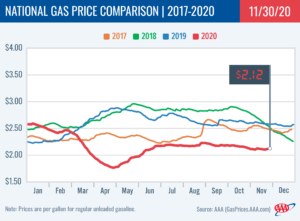
WASHINGTON, D.C. (November 30, 2020) – Following the Thanksgiving holiday, the national gas price average is more expensive. At $2.12, it is two cents more than a week ago, but remains cheaper compared to last month (-2 cents) and last year (-46 cents). Across the country, motorists in nearly 30 states are paying more at the pump on the week with states along the I-95 corridor seeing the largest jump: Delaware (+15 cents), Maryland (+8 cents), Pennsylvania (+7 cents), New Jersey (+6 cents) and North Carolina (+6 cents).
Despite the small increase at the pump, U. S. gasoline stocks increased and demand decreased, according to the Energy Information Administration’s reports for the week ending November 20. Demand dropped to 8.1 million b/d, a five month low, and stocks built by 2.2 million bbl to total 230.1 million bbl.
“As COVID-19 cases increased, the national gas price average saw it’s cheapest November in 12 years,” said Jeanette Casselano McGee, AAA spokesperson. “Motorists can expect gas prices to mostly decrease in the days ahead, especially with demand showing the lowest reading since June.”

Quick Stats
- The nation’s top 10 largest weekly increases: Delaware (+15 cents), Maryland (+8 cents), Pennsylvania (+7 cents), New Jersey (+6 cents), North Carolina (+6 cents), Indiana (+6 cents), Washington, D.C. (+5 cents), Virginia (+4 cents), Tennessee (+4 cents) and Oklahoma (+3 cents).
- The nation’s top 10 least expensive markets: Missouri ($1.76), Texas ($1.79), Mississippi ($1.81), Oklahoma ($1.82), Arkansas ($1.84), Louisiana ($1.85), Kansas ($1.87), Alabama ($1.87), South Carolina ($1.87) and Tennessee ($1.89).
Oil Market Dynamics
At the close of Friday’s formal trading session, WTI decreased by 18 cents to settle at $45.53. While domestic crude prices decreased that day, due to increasing coronavirus infection rates, crude prices grew overall last week amid increased optimism that a vaccine for the coronavirus will be available by the end of 2020. Prices were also bolstered by EIA’s weekly report revealing that total domestic crude inventories fell by 800,000 bbl to 488.7 million bbl last week.
Today and tomorrow, the Organization of the Petroleum Exporting Countries (OPEC) will meet with its partners, including Russia and Kazakhstan, to decide if they will continue status quo or increase current crude supply cuts. Either outcome could cause crude prices to continue to climb. Currently, OPEC and its allies in the production reduction agreement have agreed to cut crude output by 7.7 million b/d — approximately 8 percent of global demand — through the end of 2020.
Motorists can find current gas prices along their route with the free AAA Mobile app for iPhone, iPad and Android. The app can also be used to map a route, find discounts, book a hotel and access AAA roadside assistance. Learn more at AAA.com/mobile.
